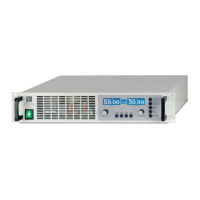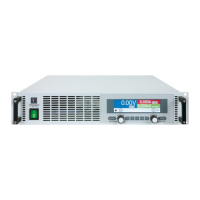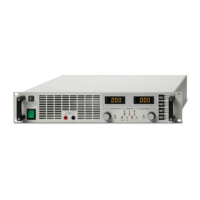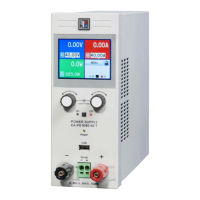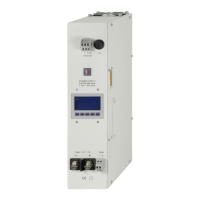32
© 2006, Elektro-Automatik GmbH & Co. KG
Irrtümer und Änderungen vorbehalten
EN
© 2009, Elektro-Automatik GmbH & Co. KG
Operating the device
8. Device setup
The device setup is intended to set parameters that are not con-
stantly altered. Three elementary settings are always available,
other settings only if a digital interface card is equipped.
The device setup can be accessed while the output is switched
off and by pressing both pushbuttons of the rotary encoders (see
section 6.3) simultaneously >2s.
All digital interface specic settings remain unmodied when
inserting a different card. Thereby, the user don‘t has to setup
the interface cards everytime the type changes.
Following elementary settings are available:
Name: Outp Rstr Default: on
Settings: on, off
Meaning: Output Restore, if set to „on“ it activates the restorati-
on of the last output state when the device was switched off or
when a blackout occured. This is intended to be used in case
the power supply is supposed to continue working as soon as it
is powered again.
Name: AI range Default: 0-10
Settings: 0-5, 0-10
Meaning: selects the control voltage range to use with the ana-
logue interface.
For all interface cards this setting applies:
Name: Device node Default: 1
Settings: 1...30
Meaning: Selects the device‘s address (device node is taken from
the CAN terminology). When using the device on a bus system
(CAN or GPIB), every device must have a unique address!
Attention! For the GPIB card only addresses between 1 and
15 can be selected, even if up to 30 are available! GPIB only
supports 15 addresses.
Following settings only with CAN interface IF-C1:
Name: Baud Default: 100k
Settings: 10k, 25k, 50k, 100k, 125k, 250k, 500k, 1M
Meaning: Selects the CAN transmission baud rate.
Name: RID Default: 0
Settings: 0...31
Meaning:Selectstherelocatableidentiersegment(RID).Refer
to CAN terminology for further information.
Name: Bus term Default: on
Settings: on, off
Meaning: activates/deactives the bus termination resistor of the
CAN interface card. This is required if the device is at the end
of the bus.
Following settings only with RS232 interface IF-R1:
Name: Baud
Default
: 57600
Settings
: 9600, 19200, 38400, 57600
Meaning: Selects the serial transmission baudrate in baud.
Further parameters for the RS232 are not congurable, but
denedasfollows:
Parity = odd
Stop bits = 1
Data bits = 8
andhavetobesettothesamecongurationatthePC.
9. Digital interface cards
The device supports following pluggable interface cards:
IF-U1 (USB)
IF-R1 (RS232)
IF-C1 (CAN)
IF-G1 (GPIB/IEEE)
IF-E1 (Ethernet/LAN + USB)
The cards require only a little or no setup after insertion. The card
specicsettingsarekept,evenifthecardisreplacedbyoneof
differenttype.Therebyitisnotnecessarytocongurethecard
settings everytime a card is inserted.
Details about the technical specs of the interface cards and the
handling, as well as instructions to implement the device into a
bus system or to control the device by means of a PC (LabView
etc.) can be found in the user manual for the IF cards.
Important! Insertion or removal only if the device is completely
switched off (power switch)!
Aboutcongurationofthepluggedcardsseesection„Devicese
-
tup“.
10. Analogue interface
10.1 General
The integrated, 15 pole analogue interface is located on the front
and offers, amongst others, following possibilities:
• Remote control of output current
• Remote control of output power (only models from 1kW)
• Remote control of output voltage
• Remote monitoring of status (OT, OVP, CC, CV)
• Remote monitoring of actual values
• Remotely switching the output on/off
The control voltage range that is going to be used is selected in the
device setup. See section 8. The reference voltage at output pin
3 is related to the chosen setting and will be either 5V or 10V.
Usage instructions:
• Controlling the device with analogue voltages requires to switch
it to remote control with pin „REMOTE“ (5).
• Before connecting the application that is used to control the
power supply, make sure to wire all leads correctly and check if
theapplicationisunabletoputinvoltageshigherthanspecied
(max. 12V).

